ACCA考试常用公式汇总,值得广西考生收藏!
发布时间:2020-01-10
距离2020年3月份的ACCA考试还有两个多月左右的时间,想必备考ACCA的同学们正在如火如荼地进行着复习。那么,今天这条“公式宝典”你一定要收好,或许会帮助你成功通过ACCA考试哦!接下来,51题库考试学习网将这份“公式宝典”分享给大家:
因为ACCA考试毕竟是国际性质的考试,因此一些题的计算可能就存在不同的计算方式,计算方式的不同也会导致结果的不同。
一、境内
1、税额=销项税-进项税
2、销项税=销售额×税率
3、视销征税无销额(1)当月类平均;(2)近类货平均,(3)组税价=成本×(1+成利率)
4、征增税及消税:
组税价=成本×(1+成润率)+消税
组税价=成本×(1+成润率)/(1-消率)
5、含税额换
不含税销额=含税销额/1+率(一般)
不含税销额=含税销额/1+征率(小规模)
6、购农销农品,或向小纳人购农品:
准扣的进税=买价×扣率(13%)
7、一般纳人外购货物付的运费
准扣的进税=运费×扣除率
*随运付的装卸、保费不扣
8、小纳人纳额=销项额×征率(6%或4%)
*不扣进额
9、小纳人不含税销额=含额/(1+征率)
10、自来水公司销水(6%)
不含税销额=发票额×(1+征率)
以上是国内物品的计算方式,接下来是国外进口的相关公式
二、进口货
1、组税价=关税完价+关税+消税
2、纳额=组税价×税率
三、出口货物退(免)税
1、"免、抵、退"计算方法(指生产企自营委外贸代出口自产)
(1)纳额=内销销税-(进税-免抵退税不免、抵税)
(2)免抵退税=FOB×外汇RMB牌价×退率-免抵退税抵减额
*FOB:出口货物离岸价。
*免抵退税抵减额=免税购原料价×退税率
免税购原料=国内购免原料+进料加工免税进料
进料加工免税进口料件组税价=到岸价+关、消税
(3)应退税和免抵税
A、如期末留抵税≤免抵退税,则:
应退税=期末留抵税
免抵税=免抵退税-应退税
B、期末留抵税>免抵退税,则:
应退税=免抵退税
免抵税=0
*期末留抵税额据《增值税纳税申报表》中"期末留抵税额"定。
(4)免抵退税不得免和抵税
免抵退税不免和抵税=FOB×外汇RMB牌价×(出口征率-出口退率)-免抵退税不免抵税抵减额
免抵退税不免和抵扣税抵减额=免税进原料价×(出口征率-出口货物退率)
2、先征后退
(1)外贸及外贸制度工贸企购货出口,出口增税免;出口后按收购成本与退税率算退税还外贸,征、退税差计企业成本
应退税额=外贸购不含增税购进金额×退税率
(2)外贸企购小纳人出货口增税退税规定:
A、从小纳人购并持普通发票准退税的抽纱、工艺品等12类出口货物,销售出口货入免,退还出口货进税
退税=[发票列(含税)销额]/(1+征率)×6%或5%
B、从小纳人购代开的增税发票的出口货:
退税=增税发票金额×6%或5%
C、外企托生企加工出口货的退税规定:
原辅料退税=国内原辅料增税发票进项×原辅料退税率
以上这些就是全部ACCA考试常用公式,希望对大家有所帮助!最后51题库考试学习网想告诉大家:“放弃可以找到一万个理由,但坚持只需一个信念!致敬那些在ACCA备考路上永不放弃的人,好结果只留给有毅力的人。”
下面小编为大家准备了 ACCA考试 的相关考题,供大家学习参考。
(b) Prepare a consolidated statement of financial position of the Ribby Group at 31 May 2008 in accordance
with International Financial Reporting Standards. (35 marks)

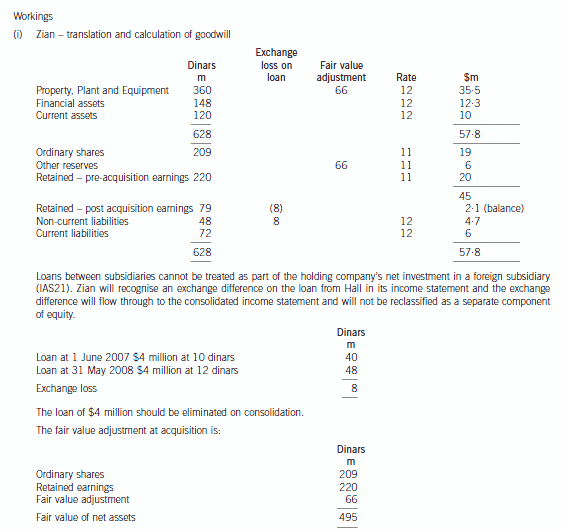


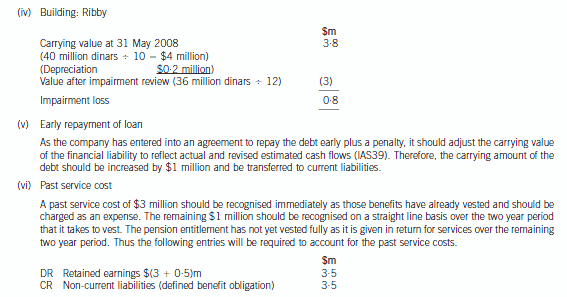
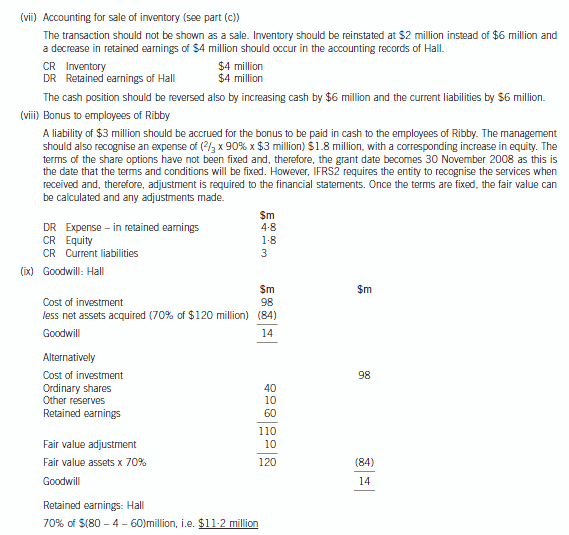
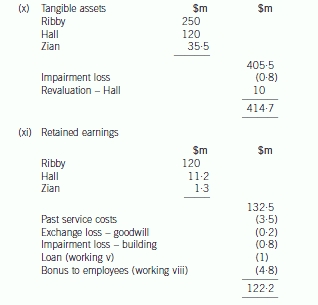

3 You are the manager responsible for the audit of Albreda Co, a limited liability company, and its subsidiaries. The
group mainly operates a chain of national restaurants and provides vending and other catering services to corporate
clients. All restaurants offer ‘eat-in’, ‘take-away’ and ‘home delivery’ services. The draft consolidated financial
statements for the year ended 30 September 2005 show revenue of $42·2 million (2004 – $41·8 million), profit
before taxation of $1·8 million (2004 – $2·2 million) and total assets of $30·7 million (2004 – $23·4 million).
The following issues arising during the final audit have been noted on a schedule of points for your attention:
(a) In September 2005 the management board announced plans to cease offering ‘home delivery’ services from the
end of the month. These sales amounted to $0·6 million for the year to 30 September 2005 (2004 – $0·8
million). A provision of $0·2 million has been made as at 30 September 2005 for the compensation of redundant
employees (mainly drivers). Delivery vehicles have been classified as non-current assets held for sale as at 30
September 2005 and measured at fair value less costs to sell, $0·8 million (carrying amount,
$0·5 million). (8 marks)
Required:
For each of the above issues:
(i) comment on the matters that you should consider; and
(ii) state the audit evidence that you should expect to find,
in undertaking your review of the audit working papers and financial statements of Albreda Co for the year ended
30 September 2005.
NOTE: The mark allocation is shown against each of the three issues.
3 ALBREDA CO
(a) Cessation of ‘home delivery’ service
(i) Matters
■ $0·6 million represents 1·4% of reported revenue (prior year 1·9%) and is therefore material.
Tutorial note: However, it is clearly not of such significance that it should raise any doubts whatsoever regarding
the going concern assumption. (On the contrary, as revenue from this service has declined since last year.)
■ The home delivery service is not a component of Albreda and its cessation does not classify as a discontinued
operation (IFRS 5 ‘Non-current Assets Held for Sale and Discontinued Operations’).
? It is not a cash-generating unit because home delivery revenues are not independent of other revenues
generated by the restaurant kitchens.
? 1·4% of revenue is not a ‘major line of business’.
? Home delivery does not cover a separate geographical area (but many areas around the numerous
restaurants).
■ The redundancy provision of $0·2 million represents 11·1% of profit before tax (10% before allowing for the
provision) and is therefore material. However, it represents only 0·6% of total assets and is therefore immaterial
to the balance sheet.
■ As the provision is a liability it should have been tested primarily for understatement (completeness).
■ The delivery vehicles should be classified as held for sale if their carrying amount will be recovered principally
through a sale transaction rather than through continuing use. For this to be the case the following IFRS 5 criteria
must be met:
? the vehicles must be available for immediate sale in their present condition; and
? their sale must be highly probable.
Tutorial note: Highly probable = management commitment to a plan + initiation of plan to locate buyer(s) +
active marketing + completion expected in a year.
■ However, even if the classification as held for sale is appropriate the measurement basis is incorrect.
■ Non-current assets classified as held for sale should be carried at the lower of carrying amount and fair value less
costs to sell.
■ It is incorrect that the vehicles are being measured at fair value less costs to sell which is $0·3 million in excess
of the carrying amount. This amounts to a revaluation. Wherever the credit entry is (equity or income statement)
it should be reversed. $0·3 million represents just less than 1% of assets (16·7% of profit if the credit is to the
income statement).
■ Comparison of fair value less costs to sell against carrying amount should have been made on an item by item
basis (and not on their totals).
(ii) Audit evidence
■ Copy of board minute documenting management’s decision to cease home deliveries (and any press
releases/internal memoranda to staff).
■ An analysis of revenue (e.g. extracted from management accounts) showing the amount attributed to home delivery
sales.
■ Redundancy terms for drivers as set out in their contracts of employment.
■ A ‘proof in total’ for the reasonableness/completeness of the redundancy provision (e.g. number of drivers × sum
of years employed × payment per year of service).
■ A schedule of depreciated cost of delivery vehicles extracted from the non-current asset register.
■ Checking of fair values on a sample basis to second hand market prices (as published/advertised in used vehicle
guides).
■ After-date net sale proceeds from sale of vehicles and comparison of proceeds against estimated fair values.
■ Physical inspection of condition of unsold vehicles.
■ Separate disclosure of the held for sale assets on the face of the balance sheet or in the notes.
■ Assets classified as held for sale (and other disposals) shown in the reconciliation of carrying amount at the
beginning and end of the period.
■ Additional descriptions in the notes of:
? the non-current assets; and
? the facts and circumstances leading to the sale/disposal (i.e. cessation of home delivery service).
(ii) Briefly discuss THREE disadvantages of using EVA? in the measurement of financial performance.
(3 marks)
(ii) Disadvantages of an EVA approach to the measurement of financial performance include:
(i) The calculation of EVA may be complicated due to the number of adjustments required.
(ii) It is difficult to use EVA for inter-firm and inter-divisional comparisons because it is not a ratio measure.
(iii) Economic depreciation is difficult to estimate and conflicts with generally accepted accounting principles.
Note: Other relevant discussion would be acceptable.
(c) Advise Alan on the proposed disposal of the shares in Mobile Ltd. Your answer should include calculations
of the potential capital gain, and explain any options available to Alan to reduce this tax liability. (7 marks)
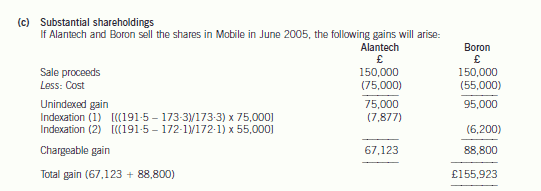
However, an exemption from corporation tax exists for any gain arising when a trading company (or member of a trading
group) sells the whole or any part of a substantial shareholding in another trading company.
A substantial shareholding is one where the investing company holds 10% of the ordinary share capital and is beneficially
entitled to at least 10% of the
(i) profits available for distribution to equity holders and
(ii) assets of the company available for distribution to equity holders on a winding up.
In meeting the 10% test, shares owned by a chargeable gains group may be amalgamated. The 10% test must have been
met for a continuous 12 month period during the 2 years preceding the disposal.
The companies making the disposals must have been trading companies (or members of a trading group) throughout the
12 month period, as well as at the date of disposal. In addition, they must also be trading companies (or members of a trading
group) immediately after the disposal.
The exemption is given automatically, and acts to deny losses as well as eliminate gains.
While Alantech Ltd has owned its holding in Mobile Ltd for 33 months, its ownership of the Boron holding has only lasted
for 10 months (at 1 June 2005) since Boron was acquired on 1 July 2004. Selling the shares in June 2005 will fail the
12 month test, and the gain will become chargeable.
It would be better for the companies to wait for a further month until July 2005 before selling the amalgamated shareholding.
By doing so, they will both be able to take advantage of the substantial shareholdings relief, thereby saving tax of £29,625
assuming a corporation tax rate of 19%.
声明:本文内容由互联网用户自发贡献自行上传,本网站不拥有所有权,未作人工编辑处理,也不承担相关法律责任。如果您发现有涉嫌版权的内容,欢迎发送邮件至:contact@51tk.com 进行举报,并提供相关证据,工作人员会在5个工作日内联系你,一经查实,本站将立刻删除涉嫌侵权内容。
- 2020-01-10
- 2020-03-14
- 2020-01-10
- 2020-08-16
- 2020-05-17
- 2020-01-10
- 2020-02-20
- 2020-05-05
- 2020-01-10
- 2020-01-10
- 2020-01-10
- 2020-04-04
- 2020-01-10
- 2020-04-10
- 2020-01-10
- 2020-01-09
- 2020-02-01
- 2020-03-27
- 2020-04-25
- 2020-01-10
- 2020-05-08
- 2020-01-10
- 2021-04-24
- 2020-05-16
- 2020-01-10
- 2020-04-24
- 2020-01-10
- 2020-01-10
- 2020-01-14
- 2020-01-10